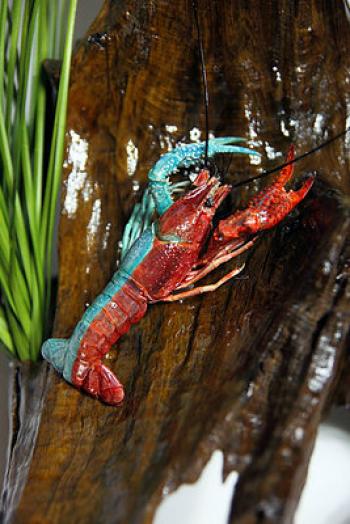
OUTDOORS: Rare blue and red crawfish found in local waters
By: JOHN FLORES
Julie Pierce and her husband Gene have seen a lot of crawfish in their lives, and why not? Gene is a commercial crawfisherman and Julie is his helper. Each year, when the weather gets right in late winter and early spring, the couple from Stephensville head into the Atchafalaya Basin to make a living.
This past spring while running their traps, one particular crawfish immediately caught the attention of the husband and wife team. The crawfish was symmetrically half red and half blue — right smack down the middle.
“I’ve seen all blue crawfish and all white crawfish,” said J. Pierce in recollecting her experiences over the years on the water with her husband, “but, I’ve never seen one in my life split down the middle like that. I even had blue crawfish that had babies and some came out red and some came out blue. But, never one that was half-and-half. That was a first for us.”
According to LSU Aquiculture Professor Greg Lutz, blue crawfish occur somewhere on the average of one in 50,000, where all white is considerably much rarer, occurring one in 5 million and a symmetrical bi-color crawfish perhaps even more rare.
“Those numbers depend on how frequent the genes occur in any given population, since crawfish carrying those genes can appear normal,” said Lutz, who has seen completely symmetrical bi-color crawfish on two occasions. “The bi-color phenomenon is completely different and it’s probably fair to say that these crawfish might occur as rarely as once in several hundred million animals. That’s just pure speculation, but you have to put that in perspective.
“If we harvest 111 million pounds of crawfish in Louisiana, just from farm acreage, plus maybe 3 to 20 more million pounds from the basin depending on weather and water conditions in any given year — and if we average 30 crawfish per pound — that’s 3.6 billion animals every year. Those are the ones that get caught.
“So, if someone were really looking for these things, we might expect to see as many as 10 or more ‘bi-color’ crawfish every year.”
J. Pierce says she named her rare crawfish “Split” for its two-sided coloration and kept it in an aquarium near her computer, where over time she became attached to it.
J. Pierce said, “It was like a pet. I know they’re not smart, but every time I would set down to my computer, it would come to the corner, because I usually fed it then. He must have known that. But, he wasn’t like the average crawfish that you’d throw in a tank and forget about.”
Other 10-legged (decapods) crustaceans that have been known to have the bi-color symmetry on rare occasions include lobsters.
Just before summer Split passed away. Pierce’s husband wanted to someway have the crawfish preserved and asked Morgan City resident Melanie Eschette, who as a hobby and sideline mounts crawfish on driftwood, if she would do it for them.
Eschette and her husband also commercially crawfish and have never seen a half-blue and half-red crawfish either.
Eschette said, “I’ve never in my life seen something like this and don’t think I ever will again. When the water is low and you go down the bayous for frogs and use a seal-beam, you can actually see crawfish on the bottom of the water crawling around. It looks like red glitter balls and their eyes are red.
“When you first catch them coming out of the water and the sun hits them they really glisten — it’s beautiful. They look like they have glitter all over them. I think crawfish are some of the most amazing creatures there is.”
Eschette, who admits to being a novice taxidermist only having been involved in the hobby for approximately 6 months, uses a clear water lacquer to coat the crustaceans she mounts. Once the lacquer is applied, the bright coloration of a live specimen is restored fully.
Eschette said, “I started doing taxidermy on crawfish and I enjoy it. But, it’s tedious work and takes about three hours to do. And, I’ll use a piece of driftwood to mount it to in order to make them look natural.”
With crawfish season just around the corner it would take quite a few sacks just to find a rare all blue crawfish, let alone one that’s all white or half blue and half red. This crawfish season before you dump a sack in the pot, you just might want to spend a little more time looking them over while purging and cleaning. You never know what you might find.
For those interested in having a crawfish mounted, you can contact Eschette at 985-498-9892.
If you wish to make a comment or have an anecdote, recipe or story you wish to share, contact John K. Flores at 985-395-5586 or by email: gowiththeflo@cox.net_
- Log in to post comments
